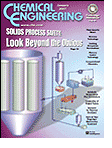Friday, January 1, 2010
Recommended :
- Subscribe FREE - Chemical Engineering
- Tips on Succession in FREE Subscription

Quick closure of valve will results sudden reversal of forward fluid flow and change in velocity. This action will subsequently results sudden momentum changes and lead to severe vibration and peak force act on the piping. In incompressible (liquid) and multiphase (two phase) fluid, it is similar to an accelerate "liquid column" hammering at a wall. The phenomena is commonly known as "water hammer". Water hammer is unlikely to occur in gas / vapor during quick valve closure due to compressible characteristic.
- Subscribe FREE - Chemical Engineering
- Tips on Succession in FREE Subscription
Quick closure of valve will results sudden reversal of forward fluid flow and change in velocity. This action will subsequently results sudden momentum changes and lead to severe vibration and peak force act on the piping. In incompressible (liquid) and multiphase (two phase) fluid, it is similar to an accelerate "liquid column" hammering at a wall. The phenomena is commonly known as "water hammer". Water hammer is unlikely to occur in gas / vapor during quick valve closure due to compressible characteristic.
Quick closure of valve results sudden change in fluid momentum (+mv to -mv) would lead to instantaneous peak force. Similarly, quick opening of valve for incompressible, multiphase and gas/vapor will results sudden change in momentum (0 to +mv) and subsequently instantaneous peak force acting on the piping. This phenomena is commonly occurs in control valve (CV), Blowdown valve (BDV) and pressure relief device i.e. pressure relief valve (PRV) and rupture disc (RD). The instantaneous peak force acting on the piping may potentially lead to piping failure. An assessment method will be presented below to assess the potential failure of piping due to quick opening of valve.
This post will particularly focus on PRV, RD and BDV with gas/ vapor discharge only.
Peak force induced by sudden gas/vapor release
When a valve quick open from FULL Close to FULL Open, instantaneously release gas/vapor from valve upstream piping to downstream piping at choking velocity results peak force (FMax, kN) as :
where
W = Vapor mass flow (kg/s)
k = Vapor specific heat ratio
Mw = Vapor molecular weight
T = Temperature (K)
Piping Limiting Force
A steel piping with Piping limiting force (FLimit, kN),
with piping wall thickness correction factor,
where
Do = Pipe external diameter (m)
Di = Pipe internal diameter (m)
Wt = Pipe wall thickness (mm)
WtSch_40 = Schedule 40 pipe wall thickness (mm)
C = Pipe support correction factor
Pipe support stiffness level and correction factor
Pipe support stiffness level and correction factor subjects to support span length (LS) and pipe external diameter (Do) which can be determined from below chart.

Assessment Criteria
To ensure piping will not failed on sudden opening of valve, the following shall be met :
FMax < 0.3 FLimit
In the event FMax is more than 0.3 but less than 0.5 of FLimit, a detail small bore connection checking shall be conducted.
Ref :
1. "Guideline for avoidance of vibration induced fatigue in process work"
Ref :
1. "Guideline for avoidance of vibration induced fatigue in process work"
Related Post
- Assess Potential Piping Failure Due to Valve Quick Opening with Two-Phase Vapor Liquid
- Quick Determination Pipe Support Stiffness Level and Correction Factor
- Check Valve Types and Selection
- Anti-surge Control (ASC) or Capacity Control (CC) Valve in Vertical Upward Run ?
- Combine Anti-surge control (ASC) & Capacity Control (CC) Functions ?
- Potential Problem associate with Double NRV in Series within a Line
- Several Strategies To Minimize Relief Capacity in Back-Flow Scenario




2 Comments:
what does T stand for in the flow induced force formula?
Thanks for highlight. Post updated.
Post a Comment
Let us know your opinion !!! You can use some HTML tags, such as <b>, <i>, <a>
Subscribe to Post Comments [Atom]
Home:
<< Home